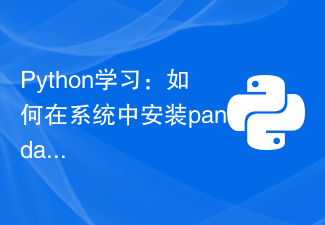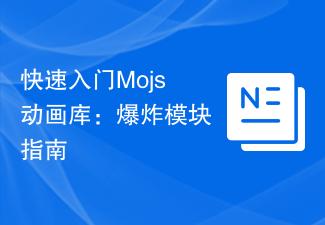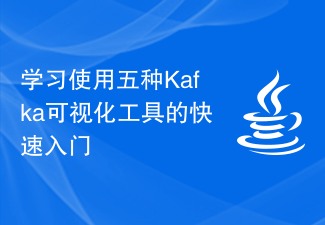
Quick Start: Install the Flask framework in one minute, specific code examples are required
Flask is a lightweight Python framework for building web applications. It is easy to learn, yet powerful, and is very suitable for beginners and the development of small projects. This article will teach you how to quickly install the Flask framework and provide specific code examples.
Step One: Install Python
Before you start installing Flask, you first need to install Python. Flask is a Python framework, so you must first install the Python interpreter. You can download the latest version of Python from the official Python website (https://www.python.org) and follow the installation wizard to install it.
Step 2: Install a virtual environment (optional)
In order to effectively manage Python packages, it is recommended that you use a virtual environment in your project. Virtual environments can create multiple independent Python running environments on the same computer to avoid conflicts between packages. You can use Python's own venv module or the third-party library virtualenv to create a virtual environment.
The following is an example of using venv to create a virtual environment:
python3 -m venv myenv
This will create a virtual environment named myenv in the current directory.
source myenv/bin/activate
This will activate the virtual environment and change your command line prompt to the name of the virtual environment.
Step 3: Install Flask
Once you have Python and your virtual environment ready, you can install Flask. Run the following command in the command line:
pip install flask
This will install the Flask package from the Python package index using the pip package manager.
Step 4: Write the first Flask application
Now, let’s write a simple Flask application and run it to verify whether our installation is successful. Create a file called app.py in your favorite code editor and write the following content:
from flask import Flask
app = Flask(__name__)
@app.route('/')
def hello():
return 'Hello, Flask!'
if __name__ == '__main__':
app.run()The above code snippet first imports the Flask module and creates a Flask application called app object. Next, use the decorator @app.route('/') to bind the hello function with the root URL ('/'). Finally, start the Flask application by calling app.run().
After saving the file, open the command line and enter the directory containing the app.py file. Run the following command to start the application:
python app.py
You will see output similar to the following:
* Running on http://127.0.0.1:5000/ (Press CTRL+C to quit)
This indicates that your Flask application has run successfully. Now, you can view the output of the application by typing http://127.0.0.1:5000/ in your browser.
Summary:
With four simple steps, you have successfully installed the Flask framework and run your first Flask application. Flask is easy to learn and suitable for beginners and small project development. I hope this article can help you quickly get started with the Flask framework and start developing your own web applications. Good luck!
The above is the detailed content of One-minute quick start guide for Flask framework installation. For more information, please follow other related articles on the PHP Chinese website!
 Python学习:如何在系统中安装pandas库Jan 09, 2024 pm 04:42 PM
Python学习:如何在系统中安装pandas库Jan 09, 2024 pm 04:42 PM快速入门:Python安装pandas库的方法,需要具体代码示例一、概述Python是一种广泛使用的编程语言,它拥有强大的开发生态系统,其中包括许多实用的库。而pandas是其中一款非常受欢迎的数据分析库,它提供了高效的数据结构和数据分析工具,使得数据处理和分析变得更加简单。本文将介绍如何在Python中安装pandas库,并提供相应的代码示例。二、安装Py
 快速入门Mojs动画库:爆炸模块指南Sep 02, 2023 pm 11:49 PM
快速入门Mojs动画库:爆炸模块指南Sep 02, 2023 pm 11:49 PM我们通过学习如何使用mojs为HTML元素添加动画来开始本系列。在第二个教程中,我们继续使用Shape模块制作内置SVG形状的动画。第三个教程介绍了使用ShapeSwirl和stagger模块对SVG形状进行动画处理的更多方法。现在,我们将学习如何使用Burst模块以突发形式制作不同SVG形状的动画。本教程将取决于我们在前三个教程中介绍的概念。如果您还没有阅读过它们,我建议您先阅读它们。创建基本连拍动画在创建任何突发动画之前,我们需要做的第一件事是实例化Burst对象。之后,我们可以指定不同属性
 快速入门:使用Go语言函数实现简单的音频流媒体服务Jul 29, 2023 pm 11:45 PM
快速入门:使用Go语言函数实现简单的音频流媒体服务Jul 29, 2023 pm 11:45 PM快速入门:使用Go语言函数实现简单的音频流媒体服务引言:音频流媒体服务在今天的数字化世界中越来越受欢迎,它可以让我们通过网络直接播放音频文件,而无需进行完整的下载。本文将介绍如何使用Go语言函数来快速实现一个简单的音频流媒体服务,以便您能更好地理解和使用这一功能。第一步:准备工作首先,您需要安装Go语言的开发环境。您可以从官方网站(https://golan
 快速入门:使用Go语言函数实现简单的图像识别功能Jul 30, 2023 pm 09:49 PM
快速入门:使用Go语言函数实现简单的图像识别功能Jul 30, 2023 pm 09:49 PM快速入门:使用Go语言函数实现简单的图像识别功能在如今的科技发展中,图像识别技术已经成为一个热门的话题。作为一种快速高效的编程语言,Go语言具备了实现图像识别功能的能力。本文将通过使用Go语言函数实现简单的图像识别功能,给读者提供一个快速入门的指南。首先,我们需要安装Go语言的开发环境。可以在Go语言官方网站(https://golang.org/)上下载适
 推荐五款Go语言常用框架,让您快速入门Feb 24, 2024 pm 05:09 PM
推荐五款Go语言常用框架,让您快速入门Feb 24, 2024 pm 05:09 PMTitle:快速上手:五款Go语言常用框架推荐近年来,随着Go语言的流行,越来越多的开发者选择采用Go进行项目开发。Go语言以其高效、简洁和性能优越等特点受到了广泛关注。在Go语言开发中,选择适合的框架能够提高开发效率和代码质量。本文将介绍五款Go语言常用框架,并附上代码示例,帮助读者快速上手。Gin框架Gin是一个轻量级的web框架,具有快速高效的特点,
 学习使用五种Kafka可视化工具的快速入门Jan 31, 2024 pm 04:32 PM
学习使用五种Kafka可视化工具的快速入门Jan 31, 2024 pm 04:32 PM快速入门:五种Kafka可视化工具的使用指南1.Kafka监控工具:简介ApacheKafka是一种分布式发布-订阅消息系统,它可以处理大量的数据,并提供高吞吐量和低延迟。由于Kafka的复杂性,需要使用可视化工具来帮助监控和管理Kafka集群。2.Kafka可视化工具:五大选择KafkaManager:KafkaManager是一个开源的Web界
 快速入门:使用Go语言函数实现简单的数据可视化折线图展示Jul 30, 2023 pm 04:01 PM
快速入门:使用Go语言函数实现简单的数据可视化折线图展示Jul 30, 2023 pm 04:01 PM快速入门:使用Go语言函数实现简单的数据可视化折线图展示引言:在数据分析和可视化的领域中,折线图是一种常用的图表类型,可以清晰地展示数据随时间或其他变量的变化趋势。本文将介绍如何使用Go语言函数来实现一个简单的数据可视化折线图展示,并且提供相关的代码实例。一、准备工作在开始之前,需要确保以下几个条件:安装Go语言环境,并设置好相关的环境变量。安装必要的依赖库
 快速入门:使用Go语言函数实现简单的消息推送功能Jul 31, 2023 pm 02:09 PM
快速入门:使用Go语言函数实现简单的消息推送功能Jul 31, 2023 pm 02:09 PM快速入门:使用Go语言函数实现简单的消息推送功能在当今移动互联网时代,消息推送已成为各种APP的标配功能。Go语言是一门快速高效的编程语言,非常适合用来开发消息推送功能。本文将介绍如何使用Go语言函数实现简单的消息推送功能,并提供相应的代码示例,帮助读者快速入门。在开始之前,我们需要了解一下消息推送的基本原理。通常,消息推送功能需要两个主要的组件:推送服务器


Hot AI Tools

Undresser.AI Undress
AI-powered app for creating realistic nude photos

AI Clothes Remover
Online AI tool for removing clothes from photos.

Undress AI Tool
Undress images for free

Clothoff.io
AI clothes remover

AI Hentai Generator
Generate AI Hentai for free.

Hot Article

Hot Tools

ZendStudio 13.5.1 Mac
Powerful PHP integrated development environment

mPDF
mPDF is a PHP library that can generate PDF files from UTF-8 encoded HTML. The original author, Ian Back, wrote mPDF to output PDF files "on the fly" from his website and handle different languages. It is slower than original scripts like HTML2FPDF and produces larger files when using Unicode fonts, but supports CSS styles etc. and has a lot of enhancements. Supports almost all languages, including RTL (Arabic and Hebrew) and CJK (Chinese, Japanese and Korean). Supports nested block-level elements (such as P, DIV),

SecLists
SecLists is the ultimate security tester's companion. It is a collection of various types of lists that are frequently used during security assessments, all in one place. SecLists helps make security testing more efficient and productive by conveniently providing all the lists a security tester might need. List types include usernames, passwords, URLs, fuzzing payloads, sensitive data patterns, web shells, and more. The tester can simply pull this repository onto a new test machine and he will have access to every type of list he needs.

WebStorm Mac version
Useful JavaScript development tools

DVWA
Damn Vulnerable Web App (DVWA) is a PHP/MySQL web application that is very vulnerable. Its main goals are to be an aid for security professionals to test their skills and tools in a legal environment, to help web developers better understand the process of securing web applications, and to help teachers/students teach/learn in a classroom environment Web application security. The goal of DVWA is to practice some of the most common web vulnerabilities through a simple and straightforward interface, with varying degrees of difficulty. Please note that this software






